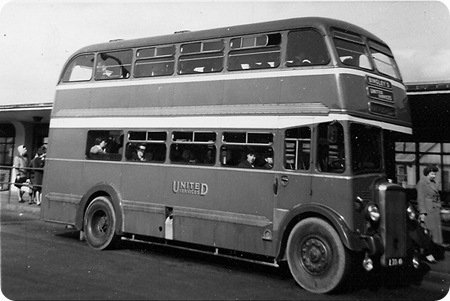United Services – Daimler CVD6 – LTO 10
United Services
1950
Daimler CVD6
Duple L56RD
I fondly remember visiting Bingley’s (one of the United Servces partners) in the mid-60s and asking Mrs Bingley ("Ma" Bingley as she was fondly known to us), whether LTO 10 was operating that day, as I wanted to photograph it. No sooner said, than she shouted for her daughter (?) who was the operations manager, and said – "Put t’Daimler on’t teatime dupe, ‘cos there’s a lad here wants to take a snap of it!" As promised, LTO 10 arrived into Wakefield bus station at about 5.30pm, and I got a (not very good) shot of it. Wonderful times which can never be repeated.
Photograph and copy contributed by Paul Haywood
The above bus was originally owned by A Skill of Nottingham and was delivered in 1950. Skills were supposed to take delivery of another CVD6 with Duple body as above but it went to W Gash & Sons instead as there DD7 (LNN 353) view at this link scroll down a bit and you will find two shots.
Spencer
———
My friend Paul has revived many happy memories of our days in the Wallace Arnold traffic office. "Ma" Bingley was Phyllis and was the "P" in "W. R. & P. Bingley – she was as Paul reports a "no nonsense" lady who quite simply got things done. That she was also a competent conjurer is beyond argument. All desperate calls from WA Hunslet for heavy assistance when summer peak demands got out of hand were calmly answered with "Ow many der yer want ??" No matter how many extra coaches we needed the necessary vehicles would appear at all hours as if by magic – fresh from pit contracts or schools or wherever – all manned by chaps who knew their place and "did as Phyllis said" without question and the impossibly large seaside passengers would all be gone without a hiccup. Slightly off the Daimler topic I admit, but Phyllis deserves an accolade as one of the real legends of the Industry.
Chris Youhill
———
Great story, Paul/Chris. Keep ’em coming! The human side is just as interesting as the bus side.
Chris Hebbron
———
10/10/12 – 09:00
The above photograph is featured on the ‘sct61’ website, along with another photo of LTO 10 in the caption of which it is asserted that Skills ordered three of these vehicles and that it was two, rather than one, which were diverted to Gash of Newark. LNN 353 (Gash DD7) was apparently intended to become Skills No.30 (LTO 30) and LRR 403 Skills No.20 (LTO 20). I haven’t been able to retrieve the Gash fleet number of LRR 403.
David Call
Quick links to the - Comments Page - Contact Page - Home Page



